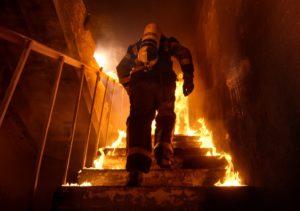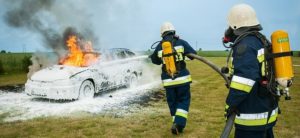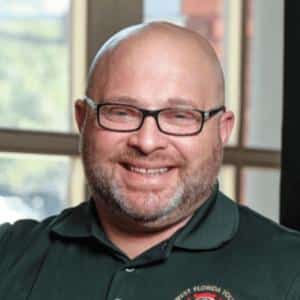Bioaccumulation and the One Nature/One Health Impacts of Occupational PFAS
Occupational PFAS (per- or poly-fluoroalkyl substances) chemicals pose a significant exposure threat to workers in many industries. The use of PFAS in building materials, cleaning supplies, protective equipment, uniforms, and personal items make occupational PFAS exposure inevitable in nearly every workplace. Our previous article in this series identified the One Nature/One Health impacts of PFAS and how these risks are magnified by bioaccumulation. Today we will discuss occupational PFAS exposure using the story of PFAS and firefighters as a cautionary tale.
 PFAS is a component of firefighting foam, and PFAS is in all three layers of protective clothing worn when fighting fires. The use of PFAS in firefighting foam and so many other products will have lasting detrimental effects on the current population and future generations. A lifelong dedication to saving lives and the property of others should never be tainted with products and materials on the job, which can increase the risk of cancer and other health concerns.
PFAS is a component of firefighting foam, and PFAS is in all three layers of protective clothing worn when fighting fires. The use of PFAS in firefighting foam and so many other products will have lasting detrimental effects on the current population and future generations. A lifelong dedication to saving lives and the property of others should never be tainted with products and materials on the job, which can increase the risk of cancer and other health concerns.
PFAS exposure is linked to multiple diseases and health issues, including cancer, thyroid disease, birth defects, endocrine disruption, miscarriage, preeclampsia, asthma, diabetes, and high cholesterol. Studies conducted by the Centers for Disease Control (CDC) identified firefighters to have a 9% higher risk of being diagnosed with cancer and a 14% higher risk of dying from cancer than the general U.S. population. Additionally, the International Association of Firefighters (IAFF) identified cancer as the cause of 66% of career firefighter line-of-duty deaths (LODD) from 2002-2019, with 70% of all LODDs in 2016 being due to cancer.
Unfortunately, active firefighters are not the only individuals at risk for PFAS-related cancers. PFAS exposure is linked to increased cancer risk in their children as well. A study of the children of county firefighters in the state of Washington found they were 27 times more likely to develop cancer than a child in the general population. No longer can we pass the issue of PFAS remediation down the line. We must break the cycle before it is too late for not only our children but our grandchildren as well.
 Firefighters are not the only ones exposed to PFAS at work. Many work-related products cause occupational PFAS exposures. One example is fabrics treated with PFAS-containing flame/stain retardants. These fabrics leech PFAS into the wearer’s sweat, and multiple studies have shown that PFAS is absorbed through the skin, thus elevating blood PFAS levels. In one study, employees and their work uniforms were tested for PFAS. The same PFAS chemicals found in the uniforms were also found in similar concentrations in the workers’ sweat and even higher levels in their blood. Another series of studies found that face masks and N95 respirators (masks) contained PFAS chemicals. Like the uniform study, wearers of PFAS-containing masks had elevated PFAS blood levels. Other studies have shown PFAS absorption from workplace sources as varied as carpets, cleaning agents, and dust.
Firefighters are not the only ones exposed to PFAS at work. Many work-related products cause occupational PFAS exposures. One example is fabrics treated with PFAS-containing flame/stain retardants. These fabrics leech PFAS into the wearer’s sweat, and multiple studies have shown that PFAS is absorbed through the skin, thus elevating blood PFAS levels. In one study, employees and their work uniforms were tested for PFAS. The same PFAS chemicals found in the uniforms were also found in similar concentrations in the workers’ sweat and even higher levels in their blood. Another series of studies found that face masks and N95 respirators (masks) contained PFAS chemicals. Like the uniform study, wearers of PFAS-containing masks had elevated PFAS blood levels. Other studies have shown PFAS absorption from workplace sources as varied as carpets, cleaning agents, and dust.
The scientific evidence documenting the risks and impacts of occupational PFAS is unquestionable. Everyone in the workplace, owners, management, and employees alike, is at risk. While some regulation exists for PFAS levels in workplaces manufacturing PFAS chemicals, regulatory agencies, including EPA and OSHA, have yet to issue exposure limits or safe workplace levels for all workplaces. Business owners and employees can reduce their occupational PFAS exposure through careful product selection, which avoids PFAS-containing products. The health risks related to occupational PFAS exposures will not be solved until regulatory agencies issue exposure limits and testing requirements for PFAS in all workplaces. Individuals and businesses have the power to influence change through their professional societies, their labor unions, and by supporting environmental organizations calling for PFAS regulation and PFAS-free alternatives.
About the Authors:

Mark Goldfeder, MS, NRP
Mark Goldfeder, MS, NRP, is the Founder and President of Five Bugles Institute, a provider of safety, leadership, and technical education nationally for over a decade. A 30-year veteran firefighter and paramedic, he is the coauthor of Five Bugles Institute’s PFAS remediation and replacement educational program. Learn more about Five Bugles Institute’s research at www.fivebuglesinstitute.com/pfas

Maurice A. Ramirez, D.O., Ph.D.
Maurice A. Ramirez, D.O., Ph.D. is the recipient of the Lifetime Achievement Award in Disaster Medicine and Co-Founder of the High Alert Institute, a 501c3 not-for-profit educational public charity dedicated to providing disaster readiness education and resources to unserved and underserved communities, industries, and charitable organizations in an All Hazards, One Health/One Nature, One Framework paradigm. Learn more about the High Alert Institute at www.HighAlertInstitute.org

